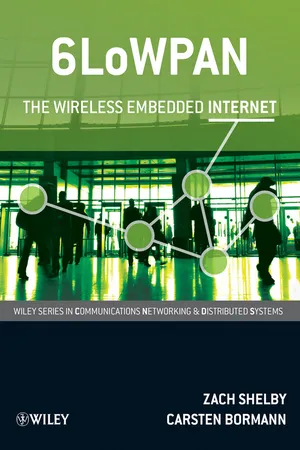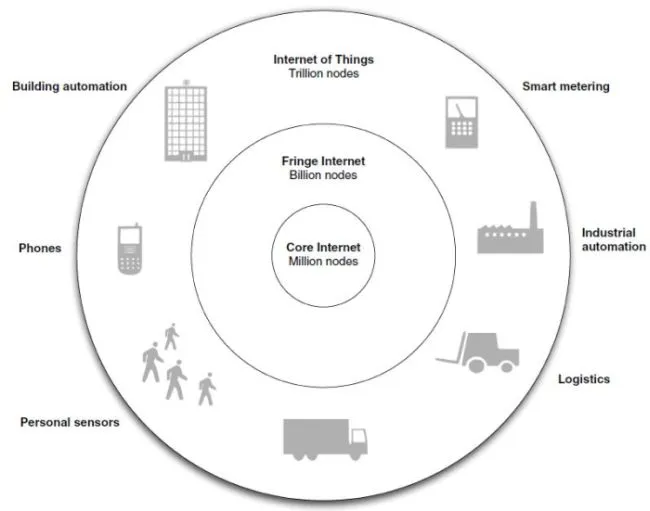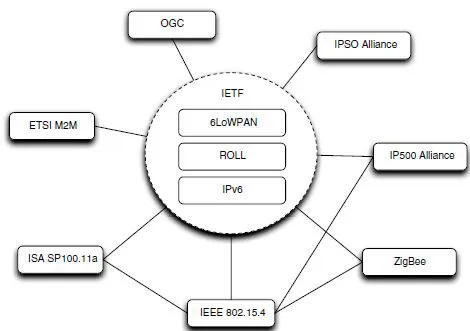![]()
1
Introduction
The Internet has been a great success over the past 20 years, growing from a small academic network into a global, ubiquitous network used regularly by over 1.4 billion people. It was the power of the Internet paradigm, tying heterogeneous networks together, and the innovative World Wide Web (WWW) model of uniform resource locators (URLs), the hypertext transfer protocol (HTTP) and universal content markup with the hypertext markup language (HTML) that made this possible. Grass-roots innovation has however been the most powerful driver behind the Internet success story. The Internet is open to innovationlike no other telecommunication system before it. This has allowed all groups involved, from Internet architects to communication engineers, IT staff and everyday users to innovate, quickly adding new protocols, services and uses for Internet technology.
As the Internet of routers, servers and personal computers has been maturing, another Internet revolution has been going on - The Internet of Things. The vision behind the Internet of Things is that embedded devices, also called smart objects, are universally becoming IP enabled, and an integral part of the Internet. Examples of embedded devices and systems using IP today range from mobile phones, personal health devices and home automation, to industrial automation, smart metering and environmental monitoring systems. The scale of the Internet of Things is already estimated to be immense, with the potential of trillions of devices becoming IP-enabled. The impact of the Internet of Things will be significant, with the promise of better environmental monitoring, energy savings, smart grids, more efficient factories, better logistics, better healthcare and smart homes.
The Internet of Things revolution started in the 1990s with industrial automation systems.Early proprietary networks in industrial automation were quickly replaced by different forms of industrial Ethernet, and Internet protocols became widely used between embedded automation devices and back-end systems. This trend has continued in all other automation segments, with Ethernet and IP becoming ubiquitous. Machine-to-machine (M2M) telemetry made a breakthrough already in the early 2000s, with the use of cellular modems and IP to monitor and control a wide range of equipment from vending machines to water pumps. Building automation systems have gone from legacy control to making wide use of wired IP communications through the Building Automation and Control Network (BACnet) and Open Building Information Exchange (oBIX) standards. More recently, automatic metering infrastructures and smart grids are being deployed at a rapid rate, largely depending on the scalability and universal availability of IP technology. Finally, mobile phones have become almost universally IP-enabled embedded devices currently making up the largest body of devices belonging to the Internet of Things.
An equally important development has been happening in the services that are used to monitor and control embedded devices. Today these services are almost universally built on Internet technology, and more commonly are implemented using web-based services. Web Service technologies have completely changed the way business and enterprise applications are designed and deployed. It is this combination of Internet-connected embedded devices and Web-based services which makes the Internet of Things a powerful paradigm.
Hundreds of millions of embedded devices are already IP-enabled, but the Internet of Things is still in its infancy in 2009. Although the capabilities of processor, power and communications technology have continuously increased, so has the complexity of communications standards, protocols and services. Thus, so far, it has been possible to use Internet capabilities in only the most powerful embedded devices. Additionally, lowpower wireless communications limits the practical bandwidth and duty-cycle available. Throughout the 1990s and early 2000s we have seen a large array of proprietary low-power embedded wireless radio and networking technologies. This has fragmented the market and slowed down the deployment of such technology.
The Institute of Electrical and Electronics Engineers (IEEE) released the 802.15.4 lowpower wireless personal area network (WPAN) standard in 2003, which was a major milestone, providing the first global low-power radio standard. Soon after, the ZigBee Alliance developed a solution for ad hoc control networks over IEEE 802.15.4, and has produced a lot of publicity about the applications of wireless embedded technology. ZigBee and proprietary networking solutions that are vertically bound to a link-layer and application profiles only solve a small portion of the applications for wireless embedded networking. They also have problems with scalability, evolvability and Internet integration. A new paradigm was needed to enable low-power wireless devices with limited processing capabilities (see Figure 1.1) to participate in the Internet of Things, forming what we call the Wireless Embedded Internet.
This book introduces a set of Internet standards which enable the use of IPv6 over lowpower wireless area networks (6LoWPAN)1, which is the key to realizing the Wireless Embedded Internet. 6LoWPAN breaks down the barriers to using IPv6 in low-power, processing-limited embedded devices over low-bandwidth wireless networks. IPv6, which is the newest version of the Internet Protocol, was developed in the late 1990s as a solution to the rapid growth and challenges facing the Internet. The further growth of the Internet of Things will be made possible thanks to IPv6.
In this chapter we give an overview of 6LoWPAN. First the Internet of Things is introduced, followed by the ideas behind 6LoWPAN, IETF standardization, related trends and applications of 6LoWPAN technology in Section 1.1. The overall 6LoWPAN architecture is then introduced in Section 1.2. A comprehensive overview of 6LoWPAN basic mechanisms and the link-layer are given in Section 1.3, followed by a 6LoWPAN network example in Section 1.4.
1.1 The Wireless Embedded Internet
What is the Internet of Things in practice? Maybe the simplest definition is that the Internet of Things encompasses all the embedded devices and networks that are natively IP-enabled and Internet-connected, along with the Internet services monitoring and controlling those devices. Figure 1.2 shows an illustration of the Internet of Things vision.
Today’s Internet is made up of a core Internet of backbone routers and servers, including millions of nodes (any kind of network device) in total. The core Internet changes rarely and has extremely high capacity. The vast majority of today’s Internet nodes are in what is sometimes called the fringe Internet. The fringe Internet includes all the personal computers, laptops and local network infrastructure connected to the Internet. This fringe changes rapidly, and is estimated to have up to a billion nodes. In 2008 it was estimated that the Internet had approximately 1.4 billion regular users, and Google announced that over a trillion unique URLs existed in their search indexes. The growth of the fringe is dependent on the number of Internet users and the personal devices used by them. The Internet of Things, sometimes referred to as the embedded fringe, is the biggest challenge and opportunityfor the Internet today. It is made up of the IP-enabled embedded devices connected to the Internet, including sensors, machines, active positioning tags, radio-frequency identification (RFID) readers and building automation equipment to name but a few. The exact size of the Internet of Things is hard to estimate, as its growth is not dependent on human users. It is assumed that the Internet of Things will soon exceed the rest of the Internet in size (number of nodes) and will continue growing at a rapid rate. The long-term potential size of the Internet of Things is in trillions of devices. The greatest growth potential in the future comes from embedded, lowpower, wireless devices and networks that until now have not been IP-enabled - the Wireless Embedded Internet. In 2008 the IP Smart Objects (IPSO) Alliance [IPSO] was formed by industry leaders to promote the use of Internet protocols by smart objects and the Internet of Things through marketing, education and interoperability.
The Wireless Embedded Internet is a subset of the Internet of Things, and the main subject of this book. We define the Wireless Embedded Internet to include resource-limited embedded devices, often battery powered, connected by low-power, low-bandwidth wireless networks to the Internet. 6LoWPAN was developedto enable the Wireless Embedded Internet by simplifying IPv6 functionality,defining very compact header formats and taking the nature of wireless networks into account [6LoWPAN].
1.1.1 Why 6LoWPAN?
There are a huge range of applications which could benefit from a Wireless Embedded Internet approach. Today these applications are implemented using a wide range of proprietary technologies which are difficult to integrate into larger networks and with Internet-based services. The benefits of using Internet protocols in these applications, and thus integrating them with the Internet of Things include [RFC4919]:
- IP-based devices can be connected easily to other IP networks without the need for translation gateways or proxies.
- IP networks allow the use of existing network infrastructure.
- IP-based technologies have existed for decades, are very well known, and have been proven to work and scale. The socket API (application programming interface) is one of the most well-known and widely used APIs in the world.
- IP technology is specified in an open and free way, with standards processes and documents available to anyone. The result is that IP technology encourages innovation and is better understood by a wider audience.
- Tools for managing, commissioning and diagnosing IP-based networks already exist (although many management protocols need optimization for direct use with 6LoWPAN Nodes as we will discuss in Chapter 5).
Until now only powerful embedded devices and networks have been able to participate natively with the Internet. Direct communication with traditional IP networks requires many Internet protocols, often requiring an operating system to deal with the complexity and maintainability. Traditional Internet protocols are demanding for embedded devices for the following reasons:
Security: IPv6 includes optional support for IP Security (IPsec) [RFC4301] authentication and encryption, and web services typically make use of secure sockets or transport layer security mechanisms. These techniques may be too complex, especially for simple embedded devices.
Web services: Internet services today rely on web-services, mainly using the transmission control protocol (TCP), HTTP, SOAP and XML with complex transaction patterns.
Management: Management with the simple network management protocol (SNMP) and web-services is often inefficient and complex.
Frame size: Current Internet protocols require links with sufficient frame length (minimum of 1280 bytes for IPv6), and heavy application protocols require substantial bandwidth.
These requirements have in practice limited the Internet of Things to devices with a powerful processor, an operating system with a full TCP/IP stack, and an IP-capable communication link. Typical embedded Internet devices today include industrial devices with Ethernet interfaces, M2M gateways with cellular modems, and advanced smart phones. A large majority of embedded applications involve limited devices, with low-power wirelessand wired network communications. Wireless embedded devices and networks are particularly challenging for Internet protocols:
Power and duty-cycle: Battery-powered wireless devices need to keep low duty cycles (the percentage of time active). The basic assumption of IP is that a device is always connected.
Multicast: Wireless embedded radio technologies, such as IEEE 802.15.4, do not typically support multicast, and flooding in such a network is wasteful of power and bandwidth. Multicast is crucial to the operation of many IPv6 features.
Mesh topologies: The applications of wireless embedded radio technology typically benefit from multihop mesh networking to achieve the required coverage and cost efficiency. Current IP routing solutions may not easily be applicable to such networks (discussed at length in Chapter 4).
Bandwidth and frame size: Low-power wireless embedded radio technology usually has limited bandwidth (on the order of 20–250 kbit/s) and frame size (on the order of 40200 bytes). In mesh topologies, bandwidth further decreases as the channel is shared and is quickly reduced by multihop forwarding.The IEEE 802.15.4 standard has a 127byte frame size, with layer-2 payload sizes as low as 72 bytes. The minimum frame size for standard IPv6 is 1280 bytes [RFC2460], thus requiring fragmentation.
Reliability: Standard Internet protocols are not optimized for low-power wireless networks. For example, TCP is not able to distinguish between packets dropped because of congestion or packets lost on wireless links. Further unreliability occurs in wireless embedded networks because of node failure, energy exhaustion and sleep duty cycles.
The IETF 6LoWPAN working group [6LoWPAN] was created to tackle these problems, and to specifically enable IPv6 to be used with wireless embedded devices and networks. Features of the IPv6 design such as a simple header structure, and its hierarchical addressing model, made it ideal for use in wireless embedded networks with 6LoWPAN. Additionally, by creating a dedicated group of standards for these networks, the minimum requirementsfor implementing a lightweight IPv6 stack with 6LoWPAN could be aligned with the most minimal devices. Finally by designing a version of Neighbor Discovery (ND) specifically for 6LoWPAN, the particular characteristics of low-power wireless mesh networks could be taken into account. The result of 6LoWPAN is the efficient extension of IPv6 into the wireless embedded domain, thus enabling end-to-end IP networking and features for a wide range of embedded applications. Refer to [RFC4919] for the detailed assumptions, problem statement and goals of early 6LoWPAN standardization. Although 6LoWPAN was targeted originally at IEEE 802.15.4 radio standards and assumed layer-2 mesh forwarding [RFC4944], it was later generalized for all similar link technologies, with additional support for IP routing in [ID-6lowpan-hc, ID-6lowpan-nd].
1.1.2 6LoWPAN history and standardization
6LoWPAN is a set of standards defined by the Internet EngineeringTask Force (IETF), whichcreates and maintains all core Internet standards and architecture work. A straightforwardtechnical definition of 6LoWPAN would be:
6LoWPAN standards enable the efficient use of IPv6 over low-power, low-rate wireless networks on simple embedded devices through an adaptation layer and the optimization of related protocols.
The IETF 6LoWPAN working group was officially started in 2005, although the history of embeddedIP goes back farther. Throughoutthe 1990s it was assumed that Moore’slaw would advance computing and communication capabilities so rapidly that soon any embedded device could implement IP protocols. Although partially true, and the Internet of Things hasgrown rapidly, it did not hold for cheap, low-power microcontrollers and low-power wireless radio technologies. The vast majority of simple embedded devices still make use of 8-bit and 16-bit microcontrollers with very limited memory, as they are low-power, small and cheap. At the same time, the physical trade-offs of wireless technology have resulted in short-range, low-power wireless radios which have limited data rates, frame sizes and duty cycles such as in the IEEE 802.15.4 standard. Early work on minimizing Internet protocols for use with lowpower microcontrollers and wireless technologies includes µIP from the Swedish Institute of Computer Science [Dunkels03] and NanoIP from the Centre for Wireless Communications [Shel03]. The IEEE 802.15.4 standard released in 2003 was the biggest factor leading to 6LoWPAN standardization. For the first time a global, widely supported standard for lowpower wireless embedded communications was available [IEEE802.15.4]. The popularity of this new standard gave the Internet community the needed encouragement to standardize an IP adaptation for such wireless embedded links.
The first 6LoWPAN specifications were released in 2007, first with an informational RFC [RFC4919] specifying the underlying requirements and goals of the initial standardization, and then with a standard track RFC [RFC4944] specifying the 6LoWPAN format and functionality. Through experience with implementations and deployments, the 6LoWPAN working group continued with improvements to header compression [ID-6lowpan-hc], 6LoWPAN Neighbor Discovery [ID-6lowpan-nd], use cases [ID-6lowpan-uc] and routing requirements [ID-6lowpan-rr]. In 2008 a new IETF working group was formed, Routing over Low-power and Lossy Networks (ROLL)[ROLL]. This working group specifies routing requirements and solutions for low-power, wireless, unreliable networks. Although not restricted to use with 6LoWPAN, that is one main target.
In 2008 ISA began standardization of a wireless industrial automation system called SP100.11a (also known as ISA100), which is based on 6LoWPAN. An overview of ISA100 is given in Chapter 7. Recent activities related to 6LoWPAN include the IP for Smart Objects (IPSO) Alliance founded in 2008 to promote the use of IP in smart objects and Internet of Things business [IPSO], and the IP500 Alliance which is developing a recommendation for 6LoWPAN over IEEE 802.15.4 sub-GHz radio communications [IP500]. Figure1.3 shows the relations between related standards bodies and alliances. The Open Geospatial Consortium (OGC) specif...



